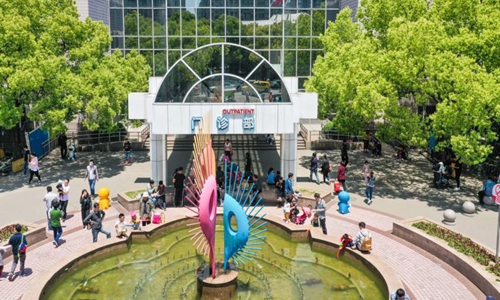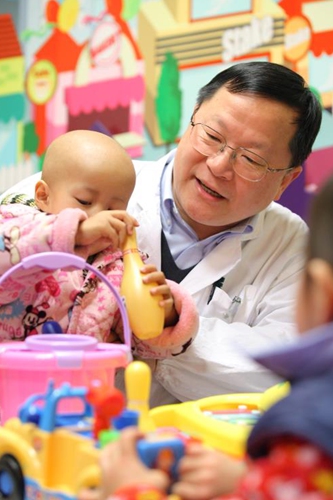Give and take: Shanghai hospital witnesses 30 years of medical exchange between China and the US
By Yu Xi in Shanghai Source:Global Times Published: 2020/4/19 19:48:40

The Shanghai Children's Medical Center building which was established in 1998 Photo: Courtesy of SCMC
The Shanghai Children's Medical Center sent 2,000 N95 masks to the US, bearing all shipping expenses in early March after receiving an urgent plea from Seattle Children's Hospital for a mask donation due to a global manufacturing shortage amid the global COVID-19 pandemic.
The Shanghai center's activity is just one of many help China has extended to other countries.
Chinese respiratory expert Zhong Nanshan and Shanghai medical expert Zhang Wenhong have both shared their experience in fighting the coronavirus pandemic with Western experts.
It's really difficult to imagine Chinese doctors could share cutting-edge technology or clinical experiences with their foreign counterparts 30 years ago, said Liu Jinfen, one of the center's founders and China's leading pediatric cardiovascular surgeons.
Located in eastern Shanghai's Pudong, Shanghai Children's Medical Center, a project jointly established by the Shanghai municipal government and US Project HOPE in the late 1980s, has been part of bilateral exchanges in the medical field between China and the US for the past 30 years.
Although China and the US have had high and low points in bilateral relations, medical exchanges have never stopped.
"It was controversial to cooperate with the US in launching such a huge project at the time. But it has been proven that we made a wise choice," Liu told the Global Times on Thursday. The US agreed to invest $25 million in equipment and personnel training, while China decided to spend about 300 million yuan (about $60 million in 1990) on the project, Liu added.
"Chinese people are always grateful in retrospect to the help from the US experts in building this hospital," Liu said.
US Project HOPE experts visited the center for the first time in 1988, after which Chinese doctors began to study overseas, marking the beginning of extensive exchanges between the two countries, Liu noted. In the early 90s, Liu himself went to the US to study cutting-edge technology for more than a year. Societal advancements like supermarkets and expressways in the US left him awestruck and made him wonder about the advent of such progress in China.

Liu Jinfen with his young patients Photo: Courtesy of SCMC
Along with closer bilateral academic exchange, high-level ties were also gradually restored. Former US First Lady Hillary Clinton came to Shanghai to cut the ribbon at the opening ceremony of the hospital in June 1998.
Thirty years ago, "our facility and equipment were poor, and our concept was outdated," Liu said, adding that Chinese medical practitioners had realized the huge gap between China and the West, and the need to redouble their efforts to catch up.
US experts also assisted in the establishment of the center. Liu recalls lauding expert Richard Jonas' efforts in particular. Jonas helped with the design and development of the cardiac department and is a witness of not only the progress in medical field but of Pudong district.
"So much has changed in Pudong. It was an area of vegetable farms. Now it's a Manhattan," said Jonas who is a world-renowned pediatric cardiac surgeon currently working as Chief of Heart Center of Children's National Medical Center in Washington DC.
"In retrospection, the US helped us, and now we help others," said Liu, noting how he and his team are often invited and welcomed by international peers. Over the years, the center has collaborated with over 10 overseas medical institutions and has established cooperative programs with more than 20 world-renowned children's hospitals.
"I'm very proud that Chinese doctors now have more say in the international community," Liu said. He and his team have performed more than 100 charitable cardiovascular surgeries for children from countries like Afghanistan, Bangladesh, and others in need.
The progress and achievements in the medical field is just a miniature aspect of Pudong's development in the past 30 years.

The new building of Shanghai Children's Medical Center Photo: Courtesy of SCMC
Puxi vs Pudong
Huangpu River divides Shanghai into two regions - Puxi, west of the river, and Pudong, the eastern region of the city.
From site selection to rapid development, Liu witnessed the establishment of the center from its conception to fruition. He chose to move to work at the center in Pudong without hesitation.
Liu insists on staying near the hospital, so he is ever-ready to examine patients and provide help in emergencies. In the early 90s, transportation in Pudong was very poor. Liu recalled being often unable to catch a bus home after hours-long operations. He had to take a ferry to go to Puxi.
"During that time, no one would like to buy a house there," Liu said. More Shanghainese now want to buy properties in Pudong due to its quality facilities.
In addition to pioneer international firms setting up shop in Pudong, modern hospitals and institutions have flooded the region. China's first proton and heavy-ion center opened in Shanghai in 2015 for cancer patients.
From age 20, Liu has spent 50 years working as a doctor. "Revere life and respect science," is how Liu sums up his experience. "As long as I'm capable of working, I will try my best to finish my job."
Posted in: IN-DEPTH,CHINA FOCUS